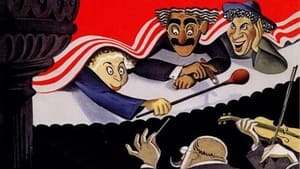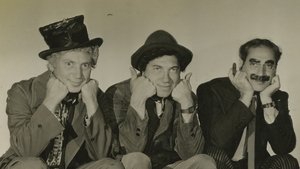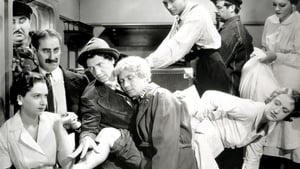Contact: info@alwanfilm.com
Video Sources 0 Views

Synopsis
Review: A Night at the Opera 1935 Colorized – A Classic Comedy Masterpiece

Introduction
In the annals of cinematic comedy, few films shine as brightly as “A Night at the Opera” (1935). Directed by Sam Wood and featuring the unparalleled Marx Brothers, this film is a cornerstone of American humor and a brilliant example of slapstick and satire. This article explores the impact of this iconic film, delving into its story, performances, critical reception, and enduring legacy.
Check The Full Colorized Movies List
Check Our Colorized Movies Trailer Channel
Understanding A Night at the Opera 1935 Colorized: Director, Cast, and Genre
“A Night at the Opera” is a 1935 comedy film directed by Sam Wood. The Marx Brothers—Groucho, Chico, and Harpo—headline the film, each bringing their unique comedic talents to the screen. Groucho’s quick wit and verbal dexterity, Chico’s whimsical piano playing and linguistic playfulness, and Harpo’s silent, anarchic mischief combine to create a film that is both hilarious and timeless.
The film also stars Kitty Carlisle as the romantic lead, Allan Jones as the aspiring tenor, and Margaret Dumont as the wealthy dowager Mrs. Claypool, a frequent foil for Groucho’s antics. The blend of slapstick, witty dialogue, and musical performances defines the genre of screwball comedy, a style that the Marx Brothers helped to popularize and perfect.
Exploring the World of A Night at the Opera 1935 Colorized: Plot and Characters
“A Night at the Opera” follows the madcap adventures of Otis B. Driftwood (Groucho Marx), Fiorello (Chico Marx), and Tomasso (Harpo Marx) as they scheme to help two young lovers, Rosa (Kitty Carlisle) and Ricardo (Allan Jones), succeed in the world of opera. The film opens with Groucho’s character attempting to secure a wealthy patron, Mrs. Claypool, for an opera company.
The narrative takes the audience from New York to a luxury ocean liner and finally to a climactic performance at the opera house. Along the way, the Marx Brothers create chaos and hilarity, whether by impersonating stowaways, disrupting high society, or sabotaging the opera performance. The film’s plot is essentially a framework for a series of comedic set pieces, each showcasing the unique talents of the Marx Brothers.
The Art of Comedy in A Night at the Opera
Comedy, particularly in the form of slapstick and satire, is an art that requires precise timing, innovative scenarios, and characters that resonate with audiences. The Marx Brothers excel in these areas, their comedic genius evident in every scene of “A Night at the Opera.” Groucho’s rapid-fire dialogue and puns, Chico’s playful misunderstandings, and Harpo’s physical comedy and expressive pantomime create a symphony of humor that is both sophisticated and accessible.
The film’s comedy extends beyond the brothers’ performances to include clever visual gags and absurd situations, such as the famous stateroom scene where an impossibly large number of people cram into a tiny cabin. This blend of verbal and physical comedy ensures that “A Night at the Opera” remains fresh and funny nearly 90 years after its release.
Early Comedy Films: A Brief History
The era of early comedy films, particularly in the 1930s, was marked by the transition from silent films to talkies. This period saw the rise of comedic legends like Charlie Chaplin, Buster Keaton, and the Marx Brothers, who brought their vaudeville and stage experience to the silver screen. The introduction of sound allowed for a new dimension of humor, incorporating dialogue and sound effects into the comedic repertoire.
Films of this era often relied on physical comedy and exaggerated scenarios, with a focus on visual gags and slapstick. The Marx Brothers, however, elevated the genre by combining these elements with sharp, witty dialogue and a keen sense of social satire, making their films both entertaining and intellectually stimulating.
A Night at the Opera and Its Cultural Significance
The release of “A Night at the Opera” in 1935 came at a time when America was recovering from the Great Depression. The film offered audiences a much-needed escape, providing laughter and levity during challenging times. Its success solidified the Marx Brothers’ status as comedic icons and demonstrated the enduring appeal of their humor.
The film’s cultural significance extends beyond its immediate impact. It has influenced generations of comedians and filmmakers, from Woody Allen to the Monty Python troupe, who have drawn inspiration from its blend of clever dialogue and slapstick. “A Night at the Opera” remains a touchstone for understanding the evolution of film comedy and the ways in which humor can address and transcend social issues.
The Debate Over the Role of Comedy in Film
The role of comedy in film has long been a subject of debate among critics and scholars. Some argue that comedy is often undervalued compared to drama, despite its ability to address serious themes through humor. The success of “A Night at the Opera” challenges this notion, proving that comedy can be both artistically significant and commercially successful.
The Marx Brothers’ films, in particular, demonstrate how comedy can be used to critique societal norms and authority figures. Their subversive humor often targets the wealthy, the pretentious, and the powerful, using laughter as a means of social commentary. This ability to entertain and provoke thought underscores the importance of comedy in the cinematic canon.
Examining A Night at the Opera as a Classic Comedy
“A Night at the Opera” stands out as a classic comedy for several reasons. Its impeccable comedic timing, innovative scenarios, and memorable performances by the Marx Brothers create a film that is both hilarious and enduring. The film’s humor is timeless, appealing to audiences across generations with its blend of verbal wit and physical comedy.
The stateroom scene, for instance, remains one of the most iconic moments in film comedy, exemplifying the Marx Brothers’ ability to create chaos out of everyday situations. Similarly, the climactic opera sequence showcases their talent for blending highbrow art with lowbrow humor, making opera accessible and entertaining to a broad audience.
Influence and Legacy: A Night at the Opera 1935 Colorized’s Impact on Cinema
The influence of “A Night at the Opera” on subsequent generations of filmmakers and comedians is profound. Its innovative approach to blending comedy with musical performance has inspired countless films and television shows. The film’s success also paved the way for other comedic ensembles, demonstrating the viability of group comedy in cinema.
The Marx Brothers’ legacy is evident in the work of contemporary comedians and filmmakers who draw on their style of humor. Their ability to combine clever wordplay with physical comedy has become a template for many successful comedies. The enduring popularity of “A Night at the Opera” attests to its lasting impact on the art of film comedy.
Director’s Cinematic Legacy: Beyond A Night at the Opera 1935 Colorized
Sam Wood, the director of “A Night at the Opera,” had a distinguished career in Hollywood, directing a wide range of films across different genres. His ability to balance the chaotic energy of the Marx Brothers with a coherent narrative structure was crucial to the film’s success. Wood’s versatility as a director is reflected in his work on other classics, such as “Goodbye, Mr. Chips” and “The Pride of the Yankees.”
While Wood’s contributions to cinema are significant, the Marx Brothers’ films remain some of his most enduring works. His collaboration with the Marx Brothers helped to refine and elevate their comedic style, resulting in a film that continues to entertain and inspire.
Themes Explored in A Night at the Opera 1935 Colorized
“A Night at the Opera” explores several themes, using humor to address issues of class, art, and society. The film’s satire targets the pretensions of high society and the exclusivity of the opera world, making sophisticated art forms accessible and entertaining to the masses. The Marx Brothers’ antics challenge social hierarchies, highlighting the absurdity of rigid class distinctions.
The film also explores the theme of love and loyalty, with the characters’ efforts to help Ricardo and Rosa achieving their dreams serving as a central plot point. Despite the chaos they create, the Marx Brothers’ characters are driven by a sense of justice and camaraderie, adding a layer of depth to the film’s comedic narrative.
Reception and Controversy Surrounding A Night at the Opera 1935 Colorized
Upon its release, “A Night at the Opera” received widespread acclaim from both critics and audiences. The film was praised for its innovative comedy, memorable performances, and satirical edge. It was a box office success, solidifying the Marx Brothers’ reputation as comedic geniuses.
However, like many works of art, the film was not without controversy. Some critics argued that the Marx Brothers’ humor was too anarchic and irreverent, challenging conventional notions of propriety and decorum. Despite these critiques, the film’s popularity and influence have only grown over time, cementing its status as a classic of American cinema.
Where to Watch A Night at the Opera 1935 Colorized Online
For those eager to experience the timeless brilliance of “A Night at the Opera,” the film is available on various streaming platforms, ensuring accessibility to audiences worldwide. Whether for the first time or the hundredth, watching this comedy masterpiece is a delightful journey into the world of the Marx Brothers’ humor.
FAQs About A Night at the Opera 1935 Colorized
Common queries surrounding “A Night at the Opera” range from its historical context to its enduring appeal. By addressing these frequently asked questions, viewers can gain a deeper understanding of the film’s significance and its place in cinematic history.
Q: What is the significance of the film’s title?
A: The title “A Night at the Opera” reflects the film’s setting within the world of opera and high society, serving as a backdrop for the Marx Brothers’ comedic escapades. It also plays on the contrast between the highbrow art form of opera and the lowbrow humor of the Marx Brothers.
Q: How did the Marx Brothers influence modern comedy?
A: The Marx Brothers’ innovative blend of verbal wit, physical comedy, and social satire has inspired generations of comedians and filmmakers. Their ability to combine humor with social commentary has had a lasting impact on the art of comedy.
Q: What are some of the film’s most iconic scenes?
A: The stateroom scene, where an absurdly large number of people squeeze into a small cabin, and the climactic opera performance, where the Marx Brothers create chaos on stage, are among the film’s most iconic and memorable moments.
Conclusion
In conclusion, “A Night at the Opera” stands as a timeless masterpiece of comedy, showcasing the genius of the Marx Brothers and their ability to blend humor with social commentary. The film’s enduring appeal lies in its innovative comedic scenarios, memorable performances, and sharp wit. As we continue to celebrate the legacy of “A Night at the Opera,” let us recognize its significant impact on the world of cinema and the art of comedy. Whether viewed in its original release or discovered anew, this classic film remains a testament to the enduring power of laughter and the brilliance of the Marx Brothers.














